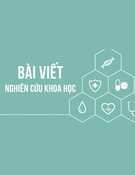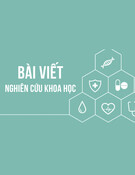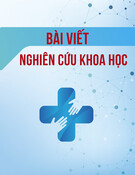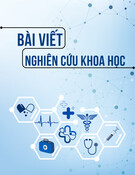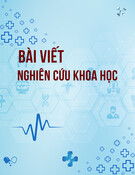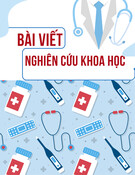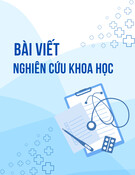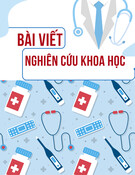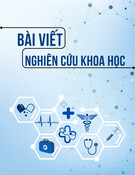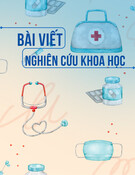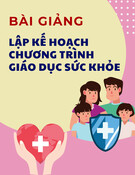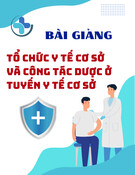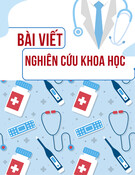
TNU Journal of Science and Technology
230(05): 309 - 315
http://jst.tnu.edu.vn 309 Email: jst@tnu.edu.vn
CLINICAL, PARACLINICAL FEATURES OF ANEMIA IN NEWBORNS AT
THE PEDIATRIC DEPARTMENT OF A HOSPITAL IN THAI NGUYEN
Pham Anh Duc*, Hoang Thi Hue
TNU - University of Medicine and Pharmacy
ARTICLE INFO
ABSTRACT
Received:
16/10/2024
The study aims to describe the clinical and paraclinical characteristics
of anemia in newborns. The subjects included 122 anemic newborns at
the Pediatric Department of A Hospital in Thai Nguyen, from August
2023 to August 2024. Cross-sectional descriptive study was used as the
main method of this study. Results showed that: clinical symptoms
included jaundice (67.2%), blue skin/pale mucous membranes (39.3%),
respiratory failure (21.3%), bleeding (17.2%), tachycardia (8.2%), and
hepatosplenomegaly (1.6%). Among them, the most common in
premature infants were jaundice (92%), respiratory failure (88%). In
full-term infants, jaundice was 60.8%, and blue skin/pale mucous
membranes were 29.9%. In premature newborns, jaundice was 68.5%,
and blue skin/pale mucous membranes were 33.3%. In late newborns,
blue skin or pale mucous membranes were observed in 85.7%, while
respiratory failure affected 64.3%. The HGB index in preterm infants
was 115.2 ± 18.6 g/l; full-term infants was 126.1 ± 11 g/l; early infants
was 126.4 ± 11.4 g/l, and late infants was 104 ,3 ± 12.8 g/l. Thus, the
most common symptoms are jaundice, blue skin/pale mucous
membranes, and respiratory failure. These symptoms have different
rates of expression in each study group. HGB, RBC and HCT indexes
decreased significantly and the differences were statistically significant
between each study group.
Revised:
06/02/2025
Published:
07/02/2025
KEYWORDS
Anemia
Newborns
Clinical
Paraclinical
Thai Nguyen
ĐẶC ĐIỂM LÂM SÀNG, CẬN LÂM SÀNG THIẾU MÁU Ở TRẺ SƠ SINH TẠI
KHOA NHI BỆNH VIỆN A THÁI NGUYÊN
Phạm Anh Đức*, Hoàng Thị Huế
Trường Đại học Y Dược - ĐH Thái Nguyên
THÔNG TIN BÀI BÁO
TÓM TẮT
Ngày nhận bài:
16/10/2024
Nghiên cứu này nhằm mô tả đặc điểm lâm sàng và cận lâm sàng của
thiếu máu ở trẻ sơ sinh. Đối tượng là 122 trẻ sơ sinh có thiếu máu tại
khoa Nhi Bệnh viện A Thái Nguyên từ tháng 8/2023 - 8/2024. Mô tả cắt
ngang là phương pháp được sử dụng trong nghiên cứu. Kết quả cho thấy
các triệu chứng lâm sàng gồm vàng da chiếm tỉ lệ 67,2%, da xanh/niêm
mạc nhợt là 39,3%, suy hô hấp là 21,3%, xuất huyết là 17,2%, nhịp tim
nhanh là 8,2%, và gan lách to là 1,6%. Trong đó, thường gặp nhất ở trẻ
non tháng là vàng da (92%), suy hô hấp (88%), ở trẻ đủ tháng vàng da
(60,8%), da xanh/ niêm mạc nhợt (29,9%), ở trẻ sơ sinh sớm vàng da
(68,5%), da xanh/niêm mạc nhợt (33,3%), ở trẻ sơ sinh muộn da
xanh/niêm mạc nhợt (85,7%), suy hô hấp (64,3%). Chỉ số HGB ở trẻ non
tháng 115,2 ± 18,6 g/l, trẻ đủ tháng 126,1 ± 11 g/l, trẻ sơ sinh sớm 126,4
± 11,4 g/l, trẻ sơ sinh muộn 104,3 ± 12,8 g/l. Như vậy, các triệu chứng
thường gặp nhất là vàng da, da xanh/ niêm mạc nhợt và suy hô hấp. Các
triệu chứng này có tỉ lệ biểu hiện khác nhau ở từng nhóm nghiên cứu.
Các chỉ số HGB, RBC và HCT giảm thấp rõ rệt và sự khác biệt có ý
nghĩa thống kê giữa từng nhóm nghiên cứu.
Ngày hoàn thiện:
06/02/2025
Ngày đăng:
07/02/2025
TỪ KHÓA
Thiếu máu
Trẻ sơ sinh
Lâm sàng
Cận lâm sàng
Thái Nguyên
DOI: https://doi.org/10.34238/tnu-jst.11335
* Corresponding author. Email: phamanhducdh97@gmail.com





